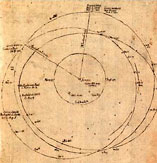Gauss’ Bet
In the early 1800’s, astronomers had just discovered a new planetoid, Ceres, when the object became impossible to track due to the glare of the sun. Surely the object would reappear some time soon; but where to look in the vast sky? The problem of predicting the location of the object, based on location data gathered during the past 40 days, became the challenge of the day for the astronomy community.
 |
The problem raised the interest of a young mathematician, Carl Friedrich Gauss, who had invented the method of least-squares at age 18. He used it (together with several other approximations) to predict the location of Ceres. His computations were so accurate as to allow the astronomer Franz Xaver von Zach to quickly relocate Ceres. The figure on the left shows a draft of Gauss’ orbital map. For more on this story, see here or here. |
Note that there is a controversy as to the identity of the inventor of the Least-Squares method, as Legendre has published it earlier than Gauss (in 1805), but Gauss claimed to have discovered it years before (see here).
